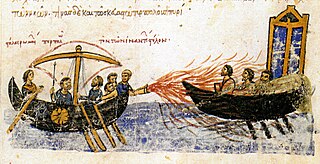 W
WThe Caspian expeditions of the Rus' were military raids undertaken by the Rus' between 864 and 1041 on the Caspian Sea shores, of what are nowadays Iran, Dagestan, and Azerbaijan. Initially, the Rus' appeared in Serkland in the 9th century traveling as merchants along the Volga trade route, selling furs, honey, and slaves. The first small-scale raids took place in the late 9th and early 10th century. The Rus' undertook the first large-scale expedition in 913; having arrived on 500 ships, they pillaged in the Gorgan region, in the territory of present-day Iran, and more to the west, in Gilan and Mazandaran, taking slaves and goods. On their return, the northern raiders were attacked and defeated by the Khazars in the Volga Delta, and those who escaped were killed by the local tribes on the middle Volga.
 W
WThe Christianization of Kievan Rus' took place in several stages. In early 867, Patriarch Photius of Constantinople announced to other Christian patriarchs that the Rus', baptized by his bishop, took to Christianity with particular enthusiasm. Photius's attempts at Christianizing the country seem to have entailed no lasting consequences, since the Primary Chronicle and other Slavonic sources describe the tenth-century Rus' as firmly entrenched in paganism. Following the Primary Chronicle, the definitive Christianization of Kievan Rus' dates from the year 988, when Vladimir the Great was baptized in Chersonesus and proceeded to baptize his family and people in Kiev. The latter events are traditionally referred to as baptism of Rus' in Ukrainian and Russian literature.
 W
WThe Battle of Dorostopol was fought in 971 between the Byzantine Empire and forces of Kievan Rus'. The Byzantines, led by John I Tzimisces, were victorious.
 W
WThe Dregoviches or Dregovichi were one of the tribal unions of Early East Slavs, and inhabited the territories down the stream of the Pripyat River and northern parts of the right bank of the Dnieper river. The name of the tribe probably derives from the Old Ruthenian word дрегва or дрягва because the Dregoviches used to live in the marshlands.
 W
WThe Drevlians were a tribe of Early East Slavs between the 6th and the 10th century, which inhabited the territories of Polesia and Right-bank Ukraine, west of the eastern Polans and along the lower reaches of the rivers Teteriv, Uzh, Ubort, and Stviga. To the west, the Drevlians' territories reached the Sluch River, where the Volynians and Buzhans lived. To the north, the Drevlians' neighbors were the Dregovichs.
 W
WKurya was the name of a Pecheneg prince and khan who allied with Svyatoslav I of Kiev in his campaigns in the Balkans. Later, after Svyatoslav's defeat by the Byzantine Empire, Kurya ambushed and killed the Kievan king at Khortytsia. According to the Chronicle of Bygone Years, Kurya had Svyatoslav's skull made into a goblet, and gilded. Dates of his rule are unknown, but he was no longer khan somewhere around 988 CE, being succeeded by Metiga. It is also possible that he was the leader of the Pechenegs in the 968 siege of Kiev, but since a starting date is unknown, it is almost impossible to tell. Kurya appears as a villain in the 2006 animated film Prince Vladimir.
 W
WThe Pechenegs or Patzinaks were a semi-nomadic Turkic people from Central Asia speaking the Pecheneg language which belonged to the Oghuz branch of the Turkic language family.
 W
WThe Radimichs were an East Slavic tribe of the last several centuries of the 1st millennium, which inhabited upper east parts of the Dnieper down the Sozh and its tributaries. The name probably derives from the name of the forefather of the tribe - Radim.
 W
WThe Rus'–Byzantine Treaty of 911 is the most comprehensive and detailed treaty concluded between the Byzantine Empire and Kievan Rus in the 10th century. It was preceded by the preliminary treaty of 907. It was the earliest written source of Old Russian Law.
 W
WThe Rus'–Byzantine War of 907 is associated in the Primary Chronicle with the name of Oleg of Novgorod. The chronicle implies that it was the most successful military operation of the Kievan Rus' against the Byzantine Empire. Paradoxically, Greek sources do not mention it at all.
 W
WThe Rus'–Byzantine War of 941 took place during the reign of Igor of Kiev. The Khazar Correspondence reveals that the campaign was instigated by the Khazars, who wished revenge on the Byzantines after the persecutions of the Jews undertaken by Emperor Romanus I Lecapenus. The first naval attack was driven off and followed by another, successful offensive in 944. The outcome was the Rus'–Byzantine Treaty of 945.
 W
WThe Siege of Kiev by the Pechenegs in 968 is documented in the Primary Chronicle, an account that freely mixes historical details with folklore.
 W
WThe Volhynians were an East Slavic tribe of the Early Middle Ages and the Principality of Volhynia in 987–1199.